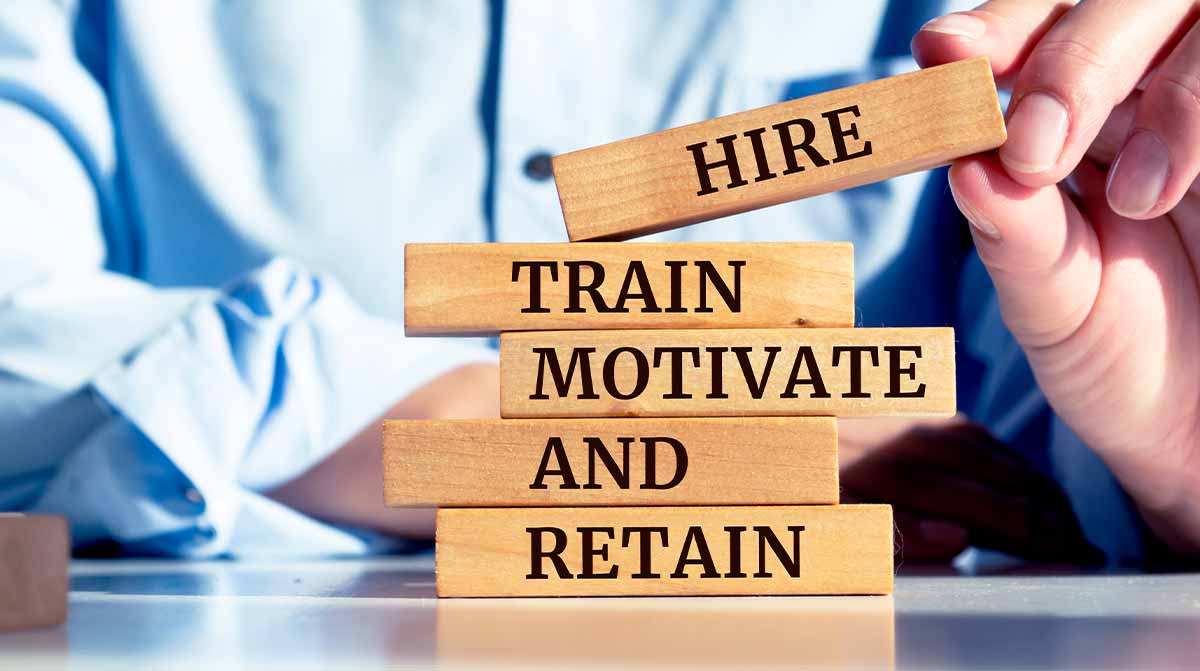Employee Experience Strategies to Improve Talent Retention and Create a Better Workplace
Employees are constantly under pressure in the workplace trying to keep up with the pace of the market, deliver high standards and be proactively two steps ahead. Over time workers break down, becoming less productive, less engaged and all together stop enjoying all aspects of their job. Thus, employee burnout becomes real as they work through the motions due to a dissatisfying employee experience (EX).
The Pandemic has shifted the way we all work, and one outcome has been a shift in the importance and focus of the employee experience. Companies and their HR team need to strategize for the “human experience” and craft EX tactics to recognize the pressure of modern work while championing the desired work-life balance, wellness, and work satisfaction.

Defining an Employee Experience Strategy
An organization’s approach to creating a positive employee experience throughout their working lifecycle is what is referred to as an employee experience strategy. HR should include everything from physical interactions to the workplace culture to produce an experience leading to improved engagement, productivity, and retention. This combination should ultimately benefit the business’s bottom line and overall success.
Poll Everywhere discusses how employee experiences impact seven stages of the employee lifecycle, which are:
- Attraction: This is the first interaction potential employees have with a company. It relates to the company’s brand, reputation, and public perception. You need to create a positive image that attracts the right talent.
- Recruitment: This happens once a potential employee decides to apply, and they step into the recruitment phase. It involves the application process, interviews, and feedback. A positive experience here would include clear communication, respectful treatment, and a seamless process.
- Onboarding: After selection, the onboarding phase ensures new hires are introduced to the company’s work culture, values, and operational procedures. A successful onboarding experience helps new employees feel welcome, integrated, and prepared.
- Development: This stage includes training programs and skill or career development opportunities. These programs make employees feel valued and invested in.
- Retention: Many factors like work environment, job satisfaction, relationships with peers and superiors, and work-life balance impact talent retention. Positive experiences at this stage lead to higher loyalty and lower employee turnover.
- Exit: Employees might leave for reasons that aren’t related to your organization. So create an offboarding process that is respectful, and constructive. It’s an opportunity to gather feedback and leave a lasting positive impression.
- Advocacy: Even after employees leave, they can act as ambassadors for the brand. Alum networks and events can result in talent referrals, business partnerships, and potential rehiring.
Human Resources professionals can help you outline employee experience strategies to implement in your organization. Below we list some examples you can use:
Implement a Solid Onboarding Program
A first, crucial step for collecting legally required information to comply is your onboarding program. Discussing company goals, mission, values, and culture help lay the foundation of the organization.
Clear objectives regarding expectations for the new role should be outlined for the new employee as to their first 30, 60, and 90 days on the job. Follow this up by regularly checking in and sharing feedback. Assign a mentor for a new hire to shadow and absorb everyday job functions for their team and company.
Implement Breaks For Casual Conversations
Creating a space for employees to share information and bond with their team and other co-workers plays a crucial role in employee engagement and comradery among the organization.
Jamie Sieja, Director of Marketing at Flex HR, says that biweekly coffee break meetings have changed how her employees feel. “We get to see one another online and share our personal and team wins and give kudos to each other, which builds individual confidence and company loyalty,” Sieja says. “Since we’ve implemented these, productivity is steady, employees seem happier and are motivated to work—building trust, accountability, general efficiency, and innovation is enhanced. This has resulted in better employee retention too.” Team-building exercises or company retreats is another way to do this.
Use Employee Feedback to Drive Change
Go straight to the source by asking employees what insights and feedback they have. HR professionals encourage managers to have an open-door policy and check in regularly with their team on how employees are feeling about their workload and tasks assigned.
Send out an engagement survey for employees to answer brief, direct questions on what they think is working within the company, what isn’t and what they would like to see change. It is important to then take those results, share the overall results by summarizing key takeaways, and then implement what changes need to be made.
Create Employee Recognition Programs
Employees just want to be heard and seen at work. When they are recognized, they tend to perform better, and productivity is more efficient. Making an employee feel this appreciation goes a long way in keeping that individual happy and feel a sense of belonging in the company. Therefore, HR should take measures to put an employee recognition policy or system in place to acknowledge a well performing staff member.
Ensure Management is Supportive
Implementing policies accompanying a positive culture based on good manager-employer relationships will help solve how employees report struggling with an unsupportive work environment.
If managers are meeting on a regular basis with employees, they should have a pretty good understanding of what is going on at work as well as outside the office. Managers should listen and lead with empathy and understanding if an employee is experiencing health issues or has lost a loved one, then recognize why that person’s energy and productivity might be lower than usual.
Provide Access to Engaging Resources
The best lessons can often be learned outside of the workplace and in places you are least expecting it. Offering a variety of resources to staff members will inspire more meaningful conversations, creative ideas, and self-confidence.
Allow for employees to request a needed resource such as a book they want that may inspire added value to their job. Surveying staff as to what resources they feel they are lacking can also be a helpful way to add more resources to the workplace.
Use Employee Lifecycle Analytics to Identify Gaps
The employee lifecycle is filled with interactions on a daily basis which all lead to how that employee perceives your company over the long run.
For this reason, Tara Furiani, the CEO of Not the HR Lady, recommends using the “Employee Life Cycle Approach” to stitch these isolated moments to identify issues. “This approach allows us to understand each phase of an employee’s career within the organization, from recruitment to retirement,” Furiani says. “It’s cutting-edge in that it leverages both qualitative and quantitative data to create an employee-centric environment, thereby aligning organizational and individual growth.”
Employees then get a look inside how staying with the company benefits them in the long run by identifying issues using an employee journey map and curating individual and team-specific action plans.
Prioritize L & D Initiatives
Learning and development (L&D) initiatives should be tailored to each employee upon hire for the purpose of that individual continuing to improve their skills on the job and drive better outcomes.
92% of HR managers say improving employee experience is an important training goal to focus on in their organization. Long-term growth opportunities boost employee engagement, confidence, productivity, and company loyalty. HR looks to L&D advantages to help develop staff members into well-qualified and distinguished employees to flourish and lead the organization’s future.
Cultivate a Sense of Trust in Leadership
Leaders of a business play a pivotal role in setting the tone and standards for the workplace. HR professionals encourage leadership to have open door policies, be communicative, consistent, and transparent in their actions, so it cultivates a sense of trust and respect among employees. Leaders should take the time to include their teams in any major decisions and do their best to create a sense of community and comradery among staff.
Foster and Inclusive Environment
Diversity, equity, and inclusion (DEI) have become a mandatory HR enterprise and should be integrated into the company’s culture. Employees want a sense of belonging, to be seen, heard, and included, so it is imperative that companies write DEI policies into their guidelines, as these are the most sought after attributes of an organization.
Foster inclusivity by conducting diversity training, setting up affinity groups, and ensuring diverse representation in leadership and decision-making roles.
Conduct Stay and Exit Interviews
Exit interviews have traditionally been a standard HR practice, however, “stay interviews” are the new proactive measure to seek feedback from current employees about what keeps them engaged and what they wish to see change or improve. Companies should choose when to schedule these employee engagement or employee satisfaction surveys, and what program to use, which could be an anonymous tool. Collecting workers thoughts on culture, management practices, digital workspace, and things they would like to see is a great way to look into how employees feel and what simple changes can be made to improve the workplace.
Use Internal Communication Tools
Communication is always key. Managers and employees who frequently converse work better together and tend to trust one another more. Slack, Trello, or other intranet systems have become welcomed communication channels used for instant collaboration and working. Employees feel a better sense of being kept in the loop and retaining information more quickly.
HR leaders recognize that offering a great employee experience is no longer a luxury, but a necessity. Employees are a company’s greatest asset, so treat them like it. HR and leaders should outline EX strategies that best fit their company culture and environment and be sure to follow through with these initiatives.
Contact Flex HR today to be your HR support at info@FlexHR.com.


